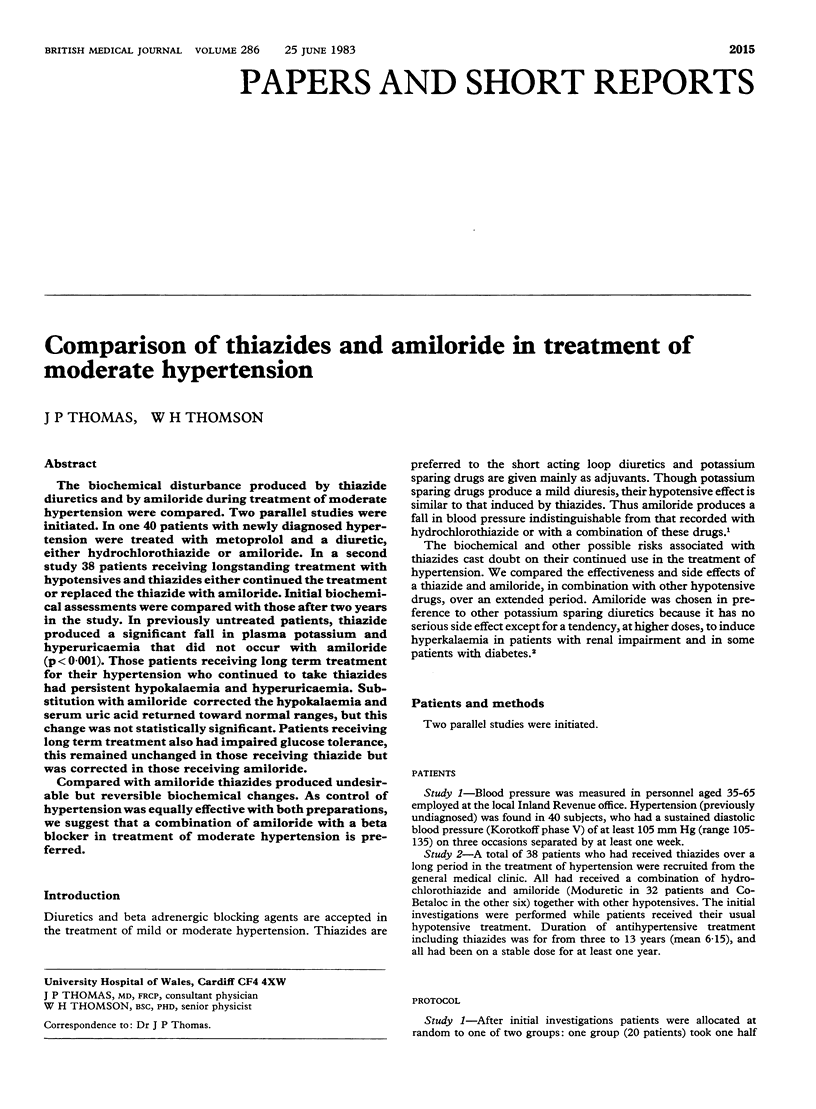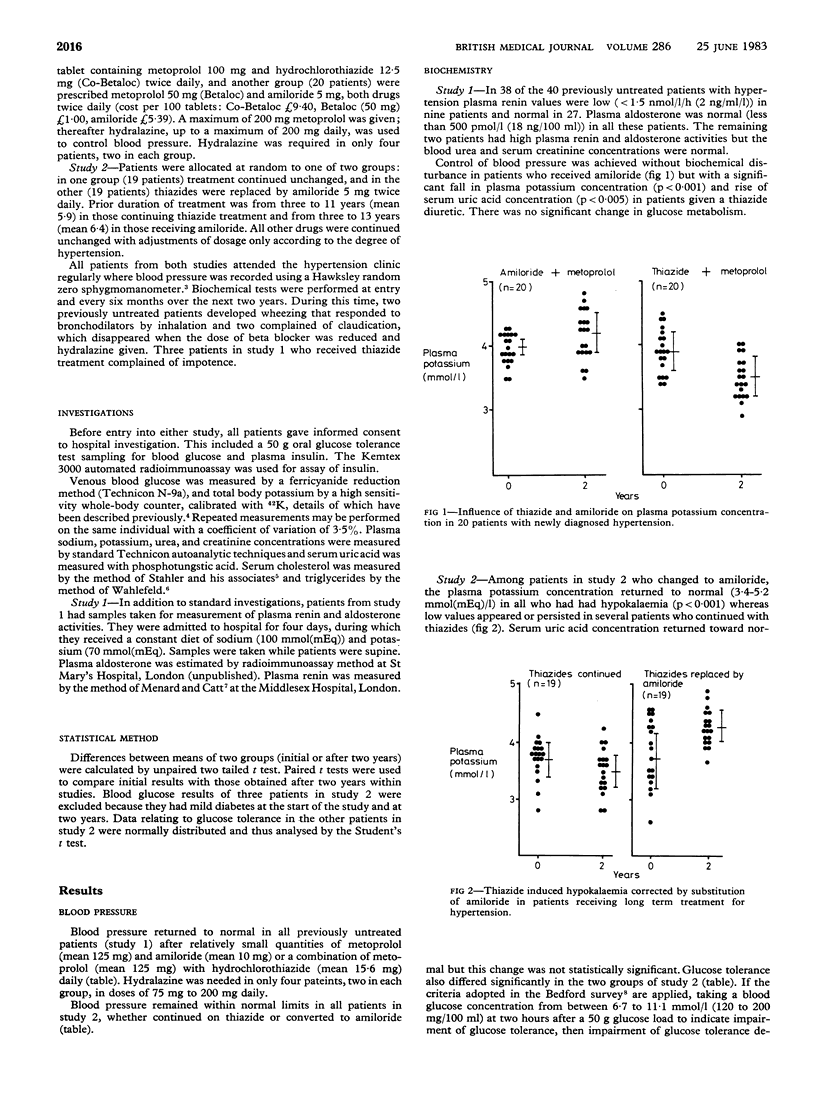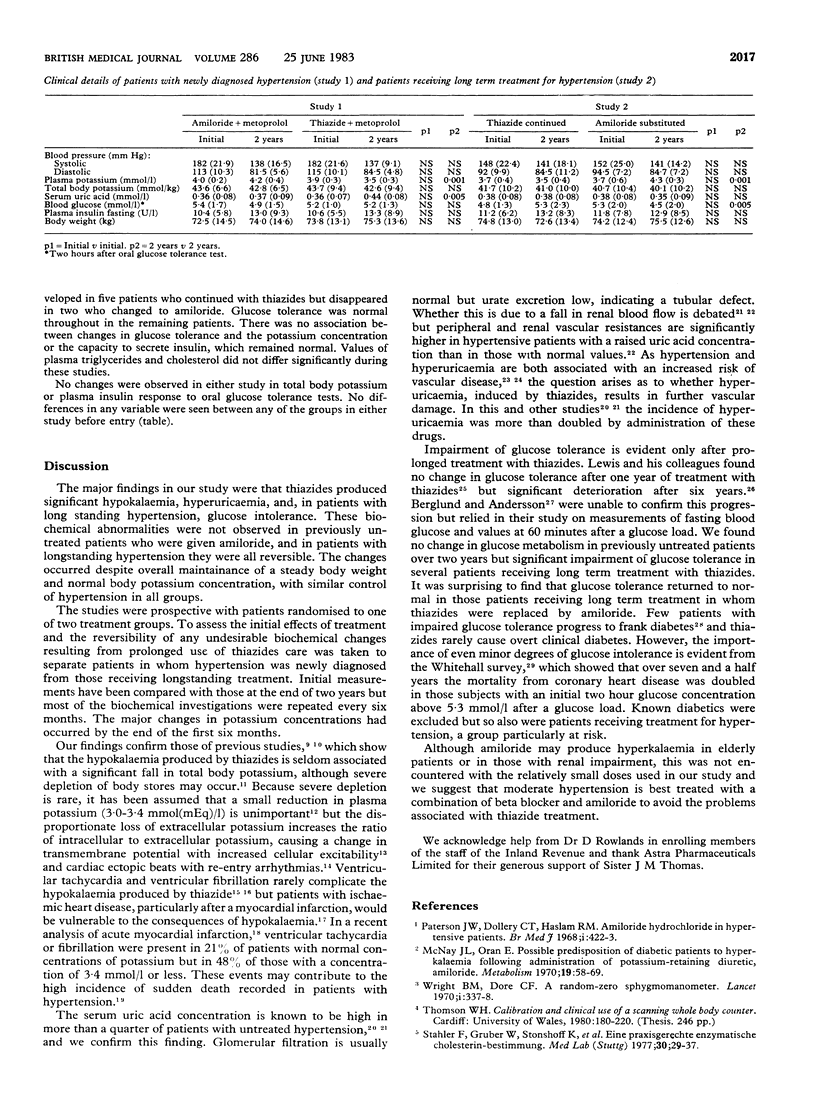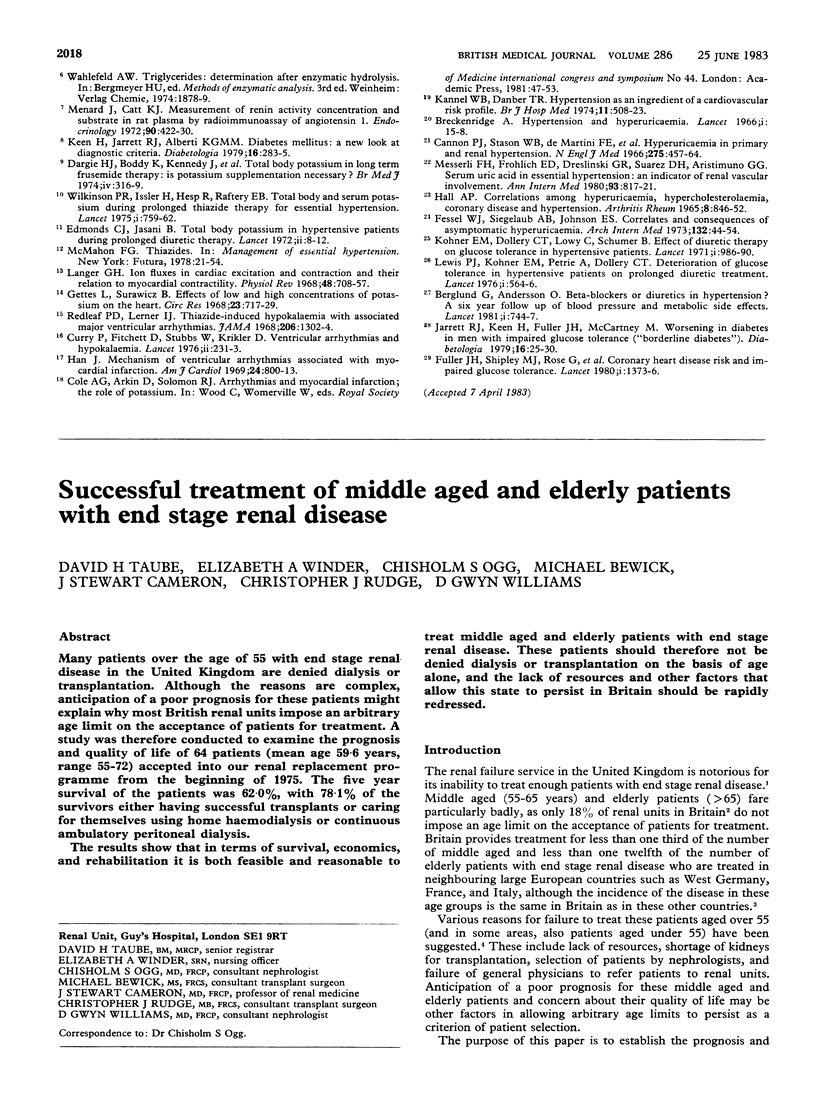Abstract
The biochemical disturbance produced by thiazide diuretics and by amiloride during treatment of moderate hypertension were compared. Two parallel studies were initiated. In one 40 patients with newly diagnosed hypertension were treated with metoprolol and a diuretic, either hydrochlorothiazide or amiloride. In a second study 38 patients receiving longstanding treatment with hypotensives and thiazides either continued the treatment or replaced the thiazide with amiloride. Initial biochemical assessments were compared with those after two years in the study. In previously untreated patients, thiazide produced a significant fall in plasma potassium and hyperuricaemia that did not occur with amiloride (p less than 0.001). Those patients receiving long term treatment for their hypertension who continued to take thiazides had persistent hypokalaemia and hyperuricaemia. Substitution with amiloride corrected the hypokalaemia and serum uric acid returned toward normal ranges, but this change was not statistically significant. Patients receiving long term treatment also had impaired glucose tolerance, this remained unchanged in those receiving thiazide but was corrected in those receiving amiloride. Compared with amiloride thiazides produced undesirable but reversible biochemical changes. As control of hypertension was equally effective with both preparations, we suggest that a combination of amiloride with a beta blocker in treatment of moderate hypertension in preferred.
Full text
PDF



Selected References
These references are in PubMed. This may not be the complete list of references from this article.
- Berglund G., Andersson O. beta-blockers or diuretics in hypertension? A six year follow-up of blood pressure and metabolic side effects. Lancet. 1981 Apr 4;1(8223):744–747. doi: 10.1016/s0140-6736(81)92624-6. [DOI] [PubMed] [Google Scholar]
- Breckenridge A. Hypertension and hyperuricaemia. Lancet. 1966 Jan 1;1(7427):15–18. doi: 10.1016/s0140-6736(66)90005-5. [DOI] [PubMed] [Google Scholar]
- Cannon P. J., Stason W. B., Demartini F. E., Sommers S. C., Laragh J. H. Hyperuricemia in primary and renal hypertension. N Engl J Med. 1966 Sep 1;275(9):457–464. doi: 10.1056/NEJM196609012750902. [DOI] [PubMed] [Google Scholar]
- Curry P., Fitchett D., Stubbs W., Krikler D. Ventricular arrhythmias and hypokalaemia. Lancet. 1976 Jul 31;2(7979):231–233. doi: 10.1016/s0140-6736(76)91029-1. [DOI] [PubMed] [Google Scholar]
- Dargie H. J., Boddy K., Kennedy A. C., King P. C., Read P. R., Ward D. M. Total body potassium in long-term frusemide therapy: is potassium supplementation necessary? Br Med J. 1974 Nov 9;4(5940):316–319. doi: 10.1136/bmj.4.5940.316. [DOI] [PMC free article] [PubMed] [Google Scholar]
- Edmonds C. J., Jasani B. Total-body potassium in hypertension patients during prolonged diuretic therapy. Lancet. 1972 Jul 1;2(7766):8–12. doi: 10.1016/s0140-6736(72)91275-5. [DOI] [PubMed] [Google Scholar]
- Fessel W. J., Siegelaub A. B., Johnson E. S. Correlates and consequences of asymptomatic hyperuricemia. Arch Intern Med. 1973 Jul;132(1):44–54. [PubMed] [Google Scholar]
- Fuller J. H., Shipley M. J., Rose G., Jarrett R. J., Keen H. Coronary-heart-disease risk and impaired glucose tolerance. The Whitehall study. Lancet. 1980 Jun 28;1(8183):1373–1376. doi: 10.1016/s0140-6736(80)92651-3. [DOI] [PubMed] [Google Scholar]
- Gettes L., Surawicz B. Effects of low and high concentrations of potassium on the simultaneously recorded Purkinje and ventricular action potentials of the perfused pig moderator band. Circ Res. 1968 Dec;23(6):717–729. doi: 10.1161/01.res.23.6.717. [DOI] [PubMed] [Google Scholar]
- Hall A. P. Correlations among hyperuricemia, hypercholesterolemia, coronary disease and hypertension. Arthritis Rheum. 1965 Oct;8(5):846–852. doi: 10.1002/art.1780080449. [DOI] [PubMed] [Google Scholar]
- Han J. Mechanisms of ventricular arrhythmias associated with myocardial infarction. Am J Cardiol. 1969 Dec;24(6):800–813. doi: 10.1016/0002-9149(69)90469-x. [DOI] [PubMed] [Google Scholar]
- Jarrett R. J., Keen H., Fuller J. H., McCartney M. Worsening to diabetes in men with impaired glucose tolerance ("borderline diabetes"). Diabetologia. 1979 Jan;16(1):25–30. doi: 10.1007/BF00423146. [DOI] [PubMed] [Google Scholar]
- Keen H., Jarrett R. J., Alberti K. G. Diabetes mellitus: a new look at diagnostic criteria. Diabetologia. 1979 May;16(5):283–285. doi: 10.1007/BF01223616. [DOI] [PubMed] [Google Scholar]
- Kohner E. M., Dollery C. T., Lowy C., Schumer B. Effect of diuretic therapy on glucose tolerance in hypertensive patients. Lancet. 1971 May 15;1(7707):986–990. doi: 10.1016/s0140-6736(71)91385-7. [DOI] [PubMed] [Google Scholar]
- Langer G. A. Ion fluxes in cardiac excitation and contraction and their relation to myocardial contractility. Physiol Rev. 1968 Oct;48(4):708–757. doi: 10.1152/physrev.1968.48.4.708. [DOI] [PubMed] [Google Scholar]
- Lewis P. J., Kohner E. M., Petrie A., Dollery C. T. Deterioration of glucose tolerance in hypertensive patients on prolonged diuretic treatment. Lancet. 1976 Mar 13;1(7959):564–566. doi: 10.1016/s0140-6736(76)90359-7. [DOI] [PubMed] [Google Scholar]
- McNay J. L., Oran E. Possible predisposition of diabetic patients to hyperkalemia following administration of potassium-retaining diuretic, amiloride (MK 870). Metabolism. 1970 Jan;19(1):58–70. doi: 10.1016/0026-0495(70)90118-6. [DOI] [PubMed] [Google Scholar]
- Menard J., Catt K. J. Measurement of renin activity, concentration and substrate in rat plasma by radioimmunoassay of angiotensin I. Endocrinology. 1972 Feb;90(2):422–430. doi: 10.1210/endo-90-2-422. [DOI] [PubMed] [Google Scholar]
- Messerli F. H., Frohlich E. D., Dreslinski G. R., Suarez D. H., Aristimuno G. G. Serum uric acid in essential hypertension: an indicator of renal vascular involvement. Ann Intern Med. 1980 Dec;93(6):817–821. doi: 10.7326/0003-4819-93-6-817. [DOI] [PubMed] [Google Scholar]
- Paterson J. W., Dollery C. T., Haslam R. M. Amiloride hydrochloride in hypertensive patients. Br Med J. 1968 Feb 17;1(5589):422–423. doi: 10.1136/bmj.1.5589.422. [DOI] [PMC free article] [PubMed] [Google Scholar]
- Redleaf P. D., Lerner I. J. Thiazide-induced hypokalemia with associated major ventricular arrhythmias. Report of a case and comment on therapeutic use of bretylium. JAMA. 1968 Nov 4;206(6):1302–1304. [PubMed] [Google Scholar]
- Stähler F., Gruber W., Stinshoff K., Röschlau P. Eine praxisgerechte enzymatische Cholesterin-Bestimmung. Med Lab (Stuttg) 1977 Feb;30(2):29–37. [PubMed] [Google Scholar]
- Wilkinson P. R., Issler H., Hesp R., Raftery E. B. Total body and serum potassium during prolonged thiazide therapy for essential hypertension. Lancet. 1975 Apr 5;1(7910):759–762. doi: 10.1016/s0140-6736(75)92432-0. [DOI] [PubMed] [Google Scholar]
- Wright B. M., Dore C. F. A random-zero sphygmomanometer. Lancet. 1970 Feb 14;1(7642):337–338. doi: 10.1016/s0140-6736(70)90709-9. [DOI] [PubMed] [Google Scholar]


